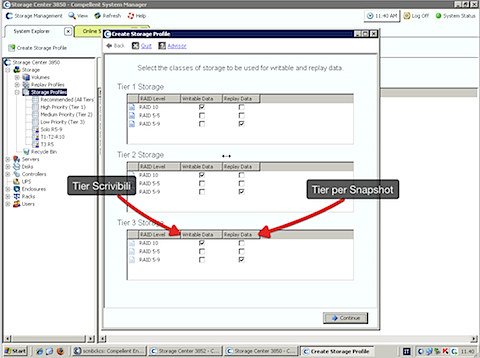Data Progression is the automated storage implementation by Compellent, nowdays we are speaking a lot about these features but i think there is a little bit of confusion on Policy based tiering and Time based tiering.
Automated storage tiering is the capability of a storage system to move blocks of data between different tiers of disks and raid levels, in function of their access frequency and application needs:
Policy and time have the same importance to accomplish a real automated tiered storage!
About Policy
Data Progression uses storage profiles to define policies. Define a storage profile is quite simple: just choose the right menu item and a wizard will po up, then you will choose where and how your data, and relative snapshots, will live: Tiers, portion of disk, RAID levels. You can span your blocks on different tiers and RAID levels but also on a single tier and/or a multiple RAID levels or any other combination possible. There are some preconfigured templates for standard workloads too, if you like the easy way.

Facts in brief:
- Storage Profiles will be assigned to LUNs or groups of LUNs and the rules will be applied immediately changing the behavior of any LUN involved.
- Storage Profiles are designed to work without any service interruption and every operation can be done on line with immediate effects on production system/data.
- Storage profiles have no dependencies from RAID groups or number of disks, when you will add new disks to the system the data will be restriped on line and you get “nothing more” than improved performance and space.
- Snapshot can be configured in the storage profiles to stay in different tiers and RAID levels than the original volume.
Last but not least, storage profiles are not disk dependent but tier dependent… when you will add SSDs on your systems the SSDs will become T1 and other disks will go down one tier without any reconfiguration or re-layout of your LUNs!
Someone uses to define storage profile as a QoS feature, in fact you can position your volumes to fit at best your needs about space and performance.
About Time
Data progression implements an algorithm to evaluate when to move blocks between tiers or RAID levels. This algorithm is, first of all, based on time. Data progression is designed on Dynamic Block Architecture and knows the age of each block and its last modification date, so it’s simple to move older blocks to less valuable tiers. DP has an internal scheduler that invokes automated scans of “lately” less accessed blocks (“lately” depends on the type of disks involved) and then move the data to low level tiers or RAID levels!
Furthermore, there are some best practices, tools, tips and tricks to force Data Progression movements more often than the default settings do.
About Time+Policy
Storage profiles and Data Progression work together to achieve the best results, you can easily fine tune your storage and take advantage of useful reports and statistics to promptly check if all is working right, if not you can modify the configuration to get immediate results!
